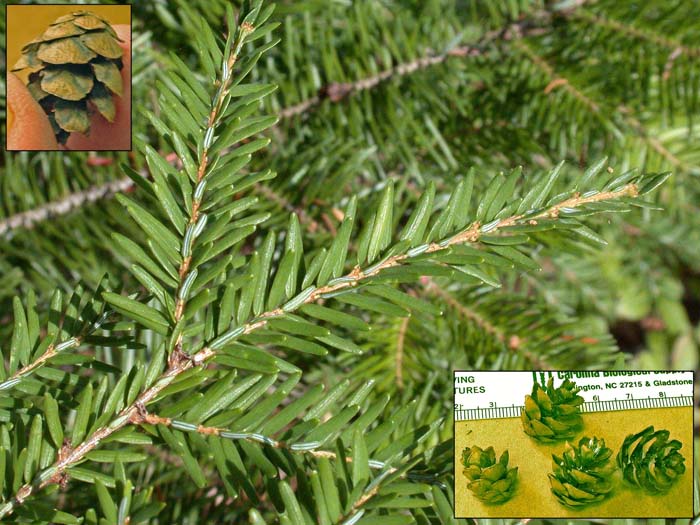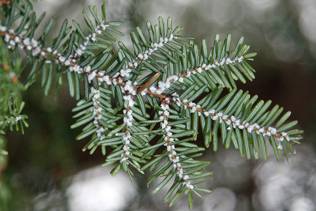Once again it is winter and the evergreen trees are taking center stage. The hemlock drops needles too much making it not a prized Christmas tree however our native hemlock looks beautiful on the snowy landscape. Tsuga canadensis has provided much-needed shelter for example the Ruffed Grouse, and food for wildlife such as the porcupine and red squirrel. Not to mention, who doesn’t love the smell of pine needles as the cold nips at your nose?
Hemlocks are also important nesting sites, food sources, and even breeding habitat for the following birds.
| Blackburnian Warblers | Yellow-rumped Warblers | Red-shouldered Hawks |
| Mourning Doves | Blue Jays | Red-breasted Nuthatch |
| Northern Flickers | Black-capped Chickadees | Boreal Chickadees |
| Common Grackles | White-winged Crossbills | Bay-breasted Warblers |
| Magnolia Warbler | American Robins | Black-throated Green Warblers |
| Evening Grosbeaks | Pine Siskins | Blue-headed Vireo |
| Dark-eyed Juncos | Red Crossbills | American Goldfinch |
| Golden-crowned Kinglet | Northern Parula | Wood Thrush |
Identifying Hemlock
First look for the Eastern Hemlock feathery silhouette, with fine, lacy twigs whose tips tend to droop gracefully. Then take a closer look for short, flat, flexible needles attached to the twig by tiny slender stalks, about ½ inch, long. They are rounded at the tip, dark green above but pale silvery below. When the tree is young, the bark is gray-brown and relatively smooth becomes cinnamon brown, with thick, ridges forming flat plates as it ages. Male flowers, which appear from April to early June appear in light-yellow clusters at the axis of needles from the preceding year. While the Female flower develops on the terminals of the previous year’s branchlets; and is pollinated by the wind. After pollination, the light green cones gradually turn into brown cones about ¾ inch long. They remain soft and flexible until the seeds are released in the fall.

Apart from this, if you would like more details on identifying hemlock and ruling out other conifers check out this article from Wild Adirondack. https://wildadirondacks.org/trees-of-the-adirondacks-eastern-hemlock-tsuga-canadensis.html
Growing Hemlock
For those with full shade and part shade consider growing a Hemlock as this is their ideal growing condition. While they can be pruned into hedges they have a delicate almost swiping cone shape when left to their own course.
Threats
The Hemlock Woolly Adelgid (HWA), is an insect pest native to Asia and accidentally introduced to the US. This invasive pest has led to the decline and mortality within four to ten years. It has thrived along the East coast, damaging hemlock forests from Maine to Georgia including 25 counties in New York State, especially in the Hudson Valley and the Finger Lakes. Consequently, climate change may accelerate the spread into the Adirondacks.

http://nyis.info/invasive_species/hemlock-woolly-adelgid/
Identifying HWA
Adult females are black and oval-bodied. But are usually concealed under the white woolly masses of woolly wax they secrete from special glands. From March through May, these females lay 50 to 300 brownish-orange eggs that hatch from April to June. The winter generation one female produces an average of 200 eggs which in turn mature. Then during the spring, they produce on average another 200 eggs each. That’s 40,000 eggs in one year, per female HWA!
Newly hatched nymphs aka crawlers are reddish-brown with a small white fringe near the front. Crawlers search for suitable sites to settle, usually at the base of the hemlock needles. They hitch a ride on the wind, feet of birds, or the fur of small mammals. This is where they begin to feed with their specialized sucking mouthparts for the rest of their lives.
HWA feeds deep within plant tissues by tapping directly into the tree’s food storage cells and not the sap. The hemlock responds by walling off the wound and this disrupts the flow of nutrients to the needles. Eventually, this leads to needles and twigs drying out and losing color until they die completely. Overall the growth will slow and there will be dieback of major limbs within two years. Generally, this process progresses from the bottom of the tree and can completely kill the tree in as little as four years.
Reporting HWA
Once you have identified HWA make sure to report it to the proper organization. For instance, if you are in New York use the iMap Invasives tool from PRISM. First, check out the helpful training they provide and then create your account. Once you have an account created, download the app, and use your smartphone to report in the field.
Eradicating HWA
At the present time, there are two approaches for managing HWA infestations chemical insecticides and biological control. Both come with pros and cons to ensure we do not do further damage to the environment. Prevention is also a good starting point. As always be careful moving plant material from infested areas especially during March – June when crawlers are most active. Keep bird feeders away from hemlocks to prevent crawlers from coming into contact with healthy trees. If a tree is heavily infested then it may be best to bring the tree down and burn it on site.
Insecticides, typically applied as a soil drench or an injection are incorporated by sap flow into the tree’s tissues. A single treatment can provide multiple years of protection. However, the costs, environmental safety, and the reproductive potential of HWA makes this approach on a broad scale unfeasible. Homeowners can first use horticultural oils and insecticidal soaps provided they apply it so it comes in contact with the HWA. Then try reducing stress in the tree by ensuring there is enough water and prune dead/dying limbs. Last but not least try to avoid nitrogen fertilizers as this can enhance the survival and reproduction of HWA.
Over the last 10 years, researchers have been investigating the use of biological control agents. At this time, scientists are evaluating the effectiveness of several HWA predators. A beetle and fungal pathogen, from Japan and the Pacific Northwest. Further study is needed to test the effectiveness on large scale and if there will be any long-term side effects from releasing another species.
